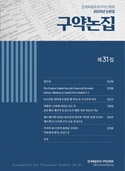본 논문은 이사야 40-55장에 나타난 출애굽 모티프를 “여호와의 팔”이라는 이미지를 중심으로 고찰한다. 구약 성경에서 출애굽 사건은 여호와의 창조적 구원을 보여주는 역사적 사건이자 미래의 구원을 위한 원형으로 기능한다. 이사야 40-55장은 이를 발전시켜 바벨론 포로에서의 해방과 종말론적 구원을 약속하는 “새 출애굽”모티프를 제시하며, "여호와의 팔"이라는 표현을 통해 하나님의 구원 방법이 어떻게 확대되고 변화되는지를 드러낸다. 특히 본 논문은 기존 연구에서 충분히 다루어지지 않은 이사야 53:1을 집중적으로 분석하여, 이 구절이 표면적으로는 출애굽 모티프가 희미하나, 실상은 이사야 52:13-53:12 본문 전체에 나타난 모세와 같은 ‘고난 받는 종’의 이미지를 통해 출애굽 내러티브를 섬세하게 변형하고 있음을 주장한다. 이사야 53:1의 “여호와의 팔”은 이스라엘을 묶고 있는 ‘죄의 속박’으로부터의 해방에 초점을 맞추며, 기존의 강력하고 현저한 방식과 달리 ‘고난 받는 종’을 통하여 하나님의 구원이 드러나는 점에서 새로운 신학적 의미를 갖는다. 이를 통해 이사야서의 ‘새 출애굽’이 첫 출애굽의 연속성을 유지하면서도 그것을 뛰어넘는 창조적이고 종말론적인 구원 사건으로 재해석되고 있음을 밝힌다. 본 논문은 이사야서의 출애굽 모티프 연구에 새로운 통찰을 제공하며, “여호와의 팔” 이미지의 신학적 함의를 제시한다.
This paper examines the Exodus motif in Isaiah 40-55, focusing on the image of the "arm of the Lord." In the Old Testament, the Exodus event functions as a historical manifestation of Yahweh's creative salvation and serves as an archetype for future deliverance. Isaiah 40-55 develops this, presenting a "new Exodus" motif that promises liberation from Babylonian captivity and eschatological salvation. Through the expression "the arm of the Lord," the text reveals how God's method of salvation is expanded and transformed. Crucially, this paper offers a focused analysis of Isaiah 53:1, a verse often underexplored in previous studies. While the Exodus motif appears faint on the surface of this verse, we argue that it subtly transforms the Exodus narrative through the image of the 'suffering servant'—a figure akin to Moses—that pervades the entire passage of Isaiah 52:13-53:12. The "arm of the Lord" in Isaiah 53:1 shifts its focus to liberation from the 'bondage of sin' that holds Israel captive. This reveals a new theological significance: unlike the powerful and overt manifestations of the arm in prior contexts, God's salvation is now revealed through the 'suffering servant.' This demonstrates that the "new Exodus" in Isaiah maintains continuity with the first Exodus while simultaneously reinterpreting it as a creative and eschatological act of salvation that transcends its predecessor. This study offers new insights into the Exodus motif in Isaiah and articulates the theological implications of the "arm of the Lord" imagery.






